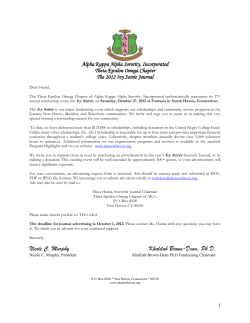
SigmaStudio Filter Coefficient Calculations
SigmaStudio Filter Coefficient Calculations This document shows how to calculate B0, B1, B2, A1, and A2 for various IIR filter types in SigmaStudio. Sin = sine, Cos = cosine, Tan = tangent, Sinh = hyperbolic sine, Log = base 10 logarithm Parametric EQ Calculation Values from Control: boost (boost of filter) frequency (center frequency) Q (Q of filter; must be greater than or equal to 0.01) gain (linear gain applied to the signal) Fs (sample rate of project) In the case that boost = 0, gainlinear = 10(gain B0 = gainlinear B1 = 0 B2 = 0 A1 = 0 A2 = 0 / 20) If boost is not 0, Create 5 new variables: a0, omega, sn, cs, alpha, Ax Ax = 10(boost / 40) omega = 2 * PI * frequency / Fs sn = Sin(omega) cs = Cos(omega) alpha = sn / (2 * (Q)) a0 = 1 + (alpha / Ax) A1 = -( 2 * cs) / a0 A2 = (1 - (alpha / Ax)) / a0 gainlinear = 10(gain / 20) / a0 B0 = (1 + (alpha * Ax)) * gainlinear B1 = -( 2 * cs) * gainlinear B2 = (1 - (alpha * Ax)) * gainlinear Tone Control Values from Control: Freq_T (treble cutoff frequency) Boost_T (treble boost) Freq_B (bass cutoff frequency) Boost_B (bass boost) Fs (sample rate of project) Boost_T = 10(Boost_T Boost_B = 10(Boost_B A_T = Tan(PI A_B = Tan(PI Knum_T = 2 / Kden_T = 2 / Knum_B = 2 / Kden_B = 2 / / 20) / 20) * Freq_T / Fs) * Freq_B / Fs) (1 + (1 / Boost_T)) (1 + Boost_T) (1 + (1 / Boost_B)) (1 + Boost_B) a10 = A_T + Kden_T a11 = A_T - Kden_T b10 = A_T + Knum_T b11 = A_T - Knum_T a20 = (A_B * Kden_B) + 1 a21 = (A_B * Kden_B) - 1 b20 = (A_B * Knum_B) - 1 b21 = (A_B * Knum_B) + 1 a0 = a10 * a20 A1 = ((a10 * a21) + (a11 * a20)) / a0 A2 = a11 * a21 gainlinear = 10(cell_gain / a0 / 20) B0 = (b10 * b20) / a0 * gainlinear B1 = ((b10 * b21) + (b11 * b20)) / a0 * gainlinear B2 = (b11 * b21) / a0 * gainlinear For double 1st Order Filter cells, simply use 2 Cascaded 1st Order Filters All Pass Values from control: frequency (center frequency) Q (Q of filter) gain1 (linear gain) fs (sample rate of project) gain1 = 10(gain / 20) omega = 2 * PI * frequency / fs sins = Sin(omega) coss = Cos(omega) alpha = sins / (2 * Q) norm = 1 + alpha B0 B1 B2 A1 A2 = = = = = gain1 * (1 - alpha) / norm gain1 * ( - 2 * coss) / norm gain1 * (1 + alpha) / norm - 2 * coss / norm (1 - alpha) / norm Notch Filter Values from control: frequency1 (center frequency) Q (Q of filter) g (gain) fs (sample rate of project) omega = frequency1 * 2 * System.PI / fs deltaomega = omega / Q b = 1 / (1 + Tan(deltaomega / 2)) gain = 10(g / 20) B0 = gain * b B1 = gain * ( - 2 * b * Cos(omega)) B2 = gain * b A1 = - 2 * b * Cos(omega) A2 = (2 * b - 1) Chebyshev Low Pass Values from control: frequency (cutoff frequency; must be 1 Hz or greater) gain (linear gain) ripple (ripple of filter; must be 0.1 or greater) Fs (sample rate of project) wp = (2 * PI * frequency) / Fs Omegap = Tan(wp / 2) epass = (10(0.1 * ripple) - 1)0.5 alpha = (0.5) * Log(1 / epass + (1 / (epass2 + 1))0.5 Omega0 = Omegap * Sinh(alpha); theta = (PI / 4) * 3 Omega1 = Omegap * Sin(theta) H0 = (1 / (1 + epass2))0.5 Den = 1 – (2 * Omega0 * Cos(theta)) + Omega02 + Omega12 G = (Omega02 + Omega12) / Den A1 A2 B0 B1 B2 = = = = = (2 (1 H0 B0 B0 * + * * (Omega02 + Omega12 - 1)) / Den (2 * Omega0 * Cos(theta)) + Omega02 + Omega12) / Den G * 10(gain / 20) 2 ChebyshevHighPass Values from control: frequency (cutoff frequency; must be 1 Hz or greater) gain (linear gain) ripple (ripple of filter; must be 0.1 or greater) Fs (sample rate of project) wp = (2 * PI * frequency) / Fs Omegap = 1 / Tan(wp / 2) epass = (10(0.1 * ripple) - 1)0.5 alpha = (0.5) * Log(1 / epass + (1 / (epass2) + 1))0.5 Omega0 = Omegap * Sinh(alpha) theta = (PI / 4) * 3 Omega1 = Omegap * Sin(theta) H0 = (1 / (1 + (epass2)))0.5 Den = 1 - 2 * Omega0 * Cos(theta) + (Omega02) + (Omega12) G = ((Omega02) + (Omega12)) / Den A1 A2 B0 B1 B2 = = = = = ( - 2 * ((Omega02) + (Omega12) - 1)) / Den (1 + 2 * Omega0 * Cos(theta) + (Omega02) + (Omega12)) / Den H0 * G * (10(gain / 20)) - B0 * 2 B0 Linkwitz-Riley – 12 dB/oct = 2 cascaded 1st order butterworths (2 biquads) frequency (the cutoff frequency) First Order type (the type of filter, can be lowpass, highpass, or allpass) g (the linear gain) fs (the sample rate of the project) 1st Order Butterworth gain = (10(g / 20)) omega, sn, cs, alpha, a0 omega = 2 * PI * frequency / fs sn = Sin(omega) cs = Cos(omega) a0 = sn + cs + 1; For a First Order lowpass… A1 = (sn - cs - 1) / a0 B0 = gain * sn / a0 B1 = gain * sn / a0 For a First Order highpass… A1 = (sn - cs - 1) / a0 B0 = gain * (1 + cs) / a0 B1 = - gain * (1 + cs) / a0 For a First Order allpass… A1 = (2.7( - 2 * PI * B0 = - gain * A1 B1 = gain frequency / fs) ) Linkwitz-Riley – 24 dB/oct = 2 cascaded 2nd order butterworths (2 biquads) frequency (the cutoff frequency) gain (the linear gain) Fs (the sample rate of the project) 2nd Order LOWPASS omega, sn, cs, alpha, a0; omega = 2 * PI * frequency / Fs sn = Sin(omega) cs = Cos(omega) alpha = sn / (2 * (1 / (2)0.5)) a0 = 1 + alpha A1 = -( 2 * cs) / a0 A2 = (1 - alpha) / a0 B1 = (1 - cs) / a0 * (10(gain / 20)) B0 = B1 / 2 B2 = B0 2nd Order HIGHPASS omega = 2 * PI * frequency / Fs sn = Sin(omega) cs = Cos(omega) alpha = sn / (2 * (1 / (2)0.5)) a0 A1 A2 B1 = = = = 1 + alpha -( 2 * cs) / a0 (1 - alpha) / a0 -( 1 + cs) / a0 * (10(gain B0 = - B1 / 2 B2 = B0 / 20) ) Linkwitz-Riley – 36 dB/oct = 2 cascaded 3rd order butterworths 3rd order butterworth is implemented by cascading a “HigherOrder” + 1st order 1st Filter: [HigherOrder] orderindex = 3, i = 0 2nd Filter: 1st Order Butterworth 3rd Filter: [HigherOrder] orderindex = 3, i = 0 4th Filter: 1st order Butterworth frequency (the cutoff frequency) gain (the linear gain) Fs (the sample rate of the project) orderindex (described above… changes based on type) i (described above) LOW PASS HIGHER ORDER omega, sn, cs, alpha, a0 , orderangle omega = 2 * PI * frequency / Fs sn = Sin(omega) cs = Cos(omega) orderangle = (PI / orderindex) * (i + 0.5) alpha = sn / (2 * (1 / (2 * Sin(orderangle)))) a0 = 1 + alpha A1 = -( 2 * cs) / a0 A2 = (1 - alpha) / a0 B1 = (1 - cs) / a0 * (10(gain / 20)) B0 = B1 / 2 B2 = B0 HIGH PASS HIGHER ORDER omega = 2 * PI * frequency / Fs sn = Sin(omega) cs = Cos(omega) orderangle = (PI / orderindex) * (i + 0.5) alpha = sn / (2 * (1 / (2 * Sin(orderangle)))) a0 = 1 + alpha A1 = -( 2 * cs) / a0 A2 = (1 - alpha) / a0 B1 = -( 1 + cs) / a0 * (10(gain / 20)) B0 = - B1 / 2 B2 = B0 Linkwitz-Riley – 48 dB/oct = 2 cascaded 4th order butterworths 4th order butterworth is implemented by cascading 2 2nd “Higher Order” using equations shown above. 1st Filter: orderindex = 4, i = 0 2nd Filter: orderindex = 4, i = 1 3rd Filter: orderindex = 4, i = 0 4th Filter: orderindex = 4, i = 1 Butterworth 12 dB/oct = One 2nd order butterworth Butterworth 18 dB/oct = One Higher order butterworth + One 1st Order Filt 1: [HigherOrder]: orderindex = 3, i = 0 Filt 2: 1st Order butterworth Butterworth 24 dB/oct = 2 Higher order butterworths Filt 1: orderindex = 4, i = 0 Filt 2: orderindex = 4, i = 1 Bessel 12 dB/oct = One 2nd order Bessel frequency, gain, Fs Low Pass Bessel omega, sn, cs, alpha, a0 omega = 2 * PI * frequency / Fs sn = Sin(omega) cs = Cos(omega) alpha = sn / (2 * (1 / (3)0.5)) a0 A1 A2 B1 = = = = 1 + alpha -( 2 * cs) / a0 (1 - alpha) / a0 (1 - cs) / a0 * (10(gain / 20) ) B0 = B1 / 2 B2 = B0 High Pass Bessel omega = 2 * PI * frequency / Fs sn = Sin(omega) cs = Cos(omega) alpha = sn / (2 * (1 / (3)0.5)) a0 A1 A2 B1 = = = = 1 + alpha -( 2 * cs) / a0 (1 - alpha) / a0 -( 1 + cs) / a0 * (10(gain / 20) ) B0 = - B1 / 2 B2 = B0 Bessel 18 dB/oct = one 2nd order Bessel + One 1st order Butterworth Bessel 24 dB/oct = Two 2nd order Besels
© Copyright 2025













